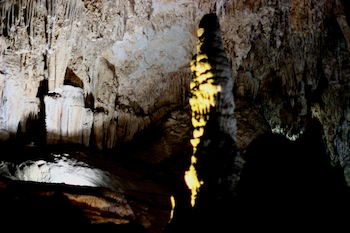Five young boys in the village of Maro, just next to Nerja , on the east coast of Sol, used to amuse themselves by looking for holes in the ground where they saw bats hiding. On the evening of January 11, 1959, they were hunting with their flashlights and saw a large number of bats flying up from the ground. The next day they returned with tools to knock away the stalactites (icicle-like formations) that hid the entrance to what appeared to be an intriguing and large cave.
A new study (2023) led by the University of Cordoba shows that the history of the Nerja Cave can be reconstructed using fossilized soot and charcoal from torches that are more than 8,000 years old. New traces bring back the history of the cave in Nerja more than previously thought. Together, the researchers show that humans have lived in Nerja for around 41,000 years, 10,000 years longer than previously thought – and that the European cave with Paleolithic art has experienced the most confirmed and frequent visits in ancient history. This latest work also presents 68 dates, 48 completely new, from the lowest parts of the cave, where Palaeolithic art and evidence of chronocultures never before documented have been discovered. "The prehistoric paintings were viewed in the flickering light of the flames, which could give the figures a certain sense of movement and warmth," explains Medina, who highlights Nerja Cave's funerary use during the latter part of antiquity for thousands of years. “There's still a lot it can reveal about what we were like,” she says.
Descending into the Nerja Caves is descending into a prehistoric and magical world
What the boys saw when they descended into the underworld was a secret that had been preserved for over 5,000 years and could be described more like a scene from a Steven Spielberg movie than reality. With open mouths and wide eyes, they shined their flashlights and stepped in large pools of bat droppings, making their way through the surreal, gigantic cave landscape until they finally came upon large piles of skeletons …. They then panicked because they thought they were former adventurers who had gotten lost in the enormous passages.
Later, it turned out that the skeletons were bodies several thousand years old, as the cave was, among other things, a burial place for Stone Age people. Namely, cave paintings and other archaeological findings show that people already lived here over 27,000 years ago (new findings, however, put these numbers back more than 10,000 years!) . In connection with an earthquake, however, the entrance to the cave collapsed and Cueva de Nerja, as the caves are now called, was relegated to the unknown wonder of the world.
In addition to historic cave paintings, tools and skeletons, the world's largest stalactite formation has been uncovered in the caves. It is 32 meters high! The caves are 35,484 square meters in size (which makes it one of the world's largest of its kind) and here are describable formations of stalactites and stalagmites that many consider to be among the world's most beautiful. The caves are still being explored so the entire surface is not open to the public.
The formations appear to be human art. Many visitors even believe that the caves in Nerja are some kind of "art installation" by the Arabs who ruled here hundreds of years ago. True, the Arabs were skilled craftsmen and artists, but it has taken mother earth an unimaginable five million years to form the stalactites and stalagmites and arrange them together into a masterpiece a human artist cannot even dream of coming close to creating.
The acoustics are phenomenal and a famous music festival is organized every year (Festival de la Cueva is always organized in the last two weeks of July). People also gather in their thousands outside the caves, barbecuing and drinking sangria all night long during the San Isidro festival in May.
In the early summer of 2015, the new botanical garden in the area was also inaugurated. It houses over 200 different species of animals, of which 42 are endangered.
If you want nice and affordable accommodation close to the caves, we recommend that you rent something in Nerja, the mountain village of Frigiliana or Maro.
By the way, our favorite area in Nerja, Capistrano Village , is less than 10 minutes' drive from the caves.
Short video with pictures from the caves in Nerja:
Facts The caves in Nerja:
Cameras are allowed but you must not have the flash on. However, a good camera and steady hands go a long way because light sources have been placed here and there along the paths.
Opening hours for the Nerja Caves
The caves are open all year round with the exception of January 1 and May 15.
Opening hours July-August: 10-19:30 (however, it closes an hour earlier during the festival week).
Remaining months: 10-14, 16-18:30.
Tip, go there in the off-season just before closing day, then you will have the opportunity to basically walk around some stretches by yourself, which feels strangely peaceful.





